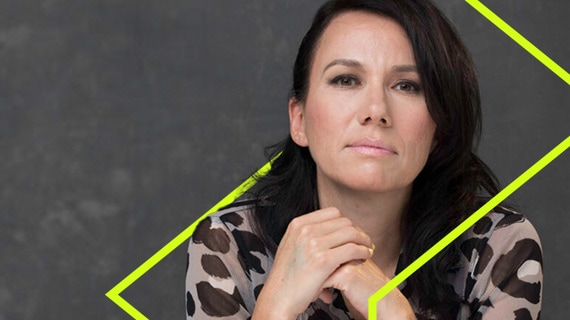Futur et Médias Podcast – Under COVID-19 Restrictions, Pre-Production and Tech Come under the Spotlight
On our French-language podcast’s inaugural episode, CMF Director of Industry and Market Trends Catherine Mathys speaks with Marc Côté, the founder and president of Montreal-based visual production services firm REAL by FAKE. Côté and his company have developed an expertise in technical pre-production, which helps productions shoot with limited crews and reduce their costs, among other advantages. Extensive pre-production work and technology, he says, are crucial elements to filming under COVID-19 restrictions.
Listen to Futur et médias on:
TV and film production is gradually resuming in most countries where it was stalled to contain the spread of COVID-19. Directors, producers, and broadcasters may be breathing a collective sigh of relief for now, but filming is about to get a lot more complicated.
Production health and safety guidelines put forward by screen-industry organizations, in Canada and elsewhere, often include caps on crew sizes, number of extras, and working hours. Add to that the impetus of physical distancing, travel restrictions, and extensive sanitizing measures and one easily understands why a lot of call sheets are heading straight to the bin.
A trained engineer, Côté has worked on several high-end films and series ― think ‘Dallas Buyers Club,’ ‘Wild,’ ‘Big Little Lies,’ ‘Sharp Objects,’ ‘The Morning Show,’ and ‘Little Fires Everywhere’ ― and is a close collaborator of director Jean-Marc Vallée. His initial focus, when he first dipped a toe in audiovisual production, has been to optimize technical pre-production. Think of it as applying post-production and VFX thinking from the onset of a project.
He didn’t know it then, but this expertise would come in pretty handy in shooting while in a pandemic.
The ‘Dallas Buyers Club’ experiment
Take ‘Dallas Buyers Club,’ for example. Production had very tight delays and an equally tight budget ― and that’s before the latter was halved. Producers switched their approach: they would film with a limited crew, without artificial lighting, and without traveling farther than the studio’s parking lot. Decors would be added digitally.
As a result, Marc Côté says the production was able to cover up to 35 percent more material per day, suffered little-to-no on-set technical delays, and shooting days were nine- to ten-hour long. “We were able to reassess our approach to lower production costs and ultimately produced a story that was closer to the author’s and the director’s vision without being limited or having to re-write parts of it,” he tells Catherine Mathys. At the 86th Academy Awards, the film received Best Picture and Best Film Editing nominations, amongst others accolades.
The same processes were implemented on a number of subsequent Jean-Marc Vallée films and series, chiefly ‘Wild,’ ‘Big Little Lies,’ and ‘Sharp Objects.’ That quaint Monterey seaside café in ‘Big Little Lies’? Completely recreated, in a studio and digitally. Dinner scenes with Reese Witherspoon and her kids? Sometimes filmed separately.
A Blueprint for COVID-Safe Production?
Today, what was once a way to save on production costs and solve actor availability issues could become the go-to approach to shooting under COVID-19 restrictions. And it’s not only for big-budget productions such as the ones mentioned above.
“It’s about doing the pre-production work and being precise in designing scenes,” Côté says.
But it doesn’t end there: game design tools could also help productions. Game engines like Unity, for example, enable game designers to create photorealistic environments that can be used in audiovisual productions. This would help solve the additional issue of pollution and environmental impacts as well ― the film and TV industries are notoriously wasteful. Think only of the amount of materials headed to landfills once a set is dismantled.
“I believe in collaboration. We have to keep our minds open. An event like the COVID-19 pandemic does not give us a choice,” Côté concludes.
> Download a translated transcript of the episode
In this episode, learn more about:
- A method developed by REAL by FAKE that redefines the way films and TV series are shot (4:14)
- The creation of virtual sets as a way to work with budget restraints (11:25)
- How technical preproduction can help solve the problem of physical proximity between cast and crew (14:00)
- The role the video game industry can play in helping to get film and TV productions off the ground (18:48)
- The essential collaboration between the various players in the audiovisual industry, in order to face the COVID-19 crisis (23:10)
Dig deeper
- For an overview of the REAL by FAKE portfolio, check out their Vimeo page;
- Read this case study about a technological solution that was developed specifically for ‘Big Little Lies’;
- Read Des pistes de solution pour une reprise des tournages [in French], which features an interview with Marc Côté, in La Presse;
- Discover the potential of Unreal Engine 5 in developing virtual sets that appear larger than life;
- Read The Great Film Production Renaissance: Are You Ready? by Richard Janes on Medium;
- Read Reopening Hollywood: How VFX Can Solve On-Set Social Distancing Dilemmas on Deadline;
- Read The filmmaking technology behind ‘The Mandalorian’ is straight out of the Star Wars universe on Quartz;
- Visit TurboSquid, an online market where virtual sets and design elements are sold
- Read TFO Is Using A Video Game Engine to Make TV, And It’s Working by Patrick Faller on CMF Trends.
Listen on:







